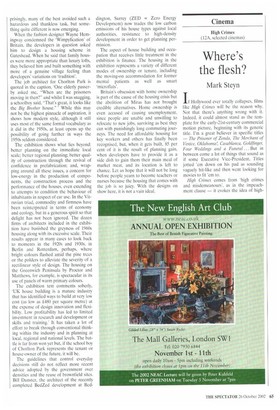Architecture
Coming Homes (RIBA. 66 Portland Place. till 11 January)
Steps into the future
Alan Powers The new housing at Chorlton Park, Manchester for the Irwell Housing Association, designed by Stephenson Bell, uses green oak posts from wind-damaged French forests. This is not a fringe manifestation of eco-obsessive architecture, high up in a Welsh valley, but part of a new mainstream culture of housing architecture, according to the exhibition Coming Homes, organised by Rob Wilson at the RIBA. This is one of the best exhibitions there in recent years, which is good, because the subject is the most important one that architects can address, and it is still considered less glamorous than building airports or museums. The past 30 years of housing in Britain have been blighted by a sense of failure as architects were first blamed, not without reason, for their monstrous mistakes, then public housing as a concept shrank to nearly nothing. Not sur
prisingly, many of the best avoided such a hazardous and thankless task, but something quite different is now emerging.
When the fashion designer Wayne Hemingway condemned the `Wimpyfication' of Britain, the developers in question asked him to design a housing scheme in Gateshead. When he said that family houses were more appropriate than luxury lofts, they believed him and built something with more of a genuine village feeling than developers' variations on tradition'.
The job architect for Chorlton Park is quoted in the caption, 'One elderly passerby asked me, "When are the prisoners moving in then?and whilst I was snagging, a schoolboy said, "That's great, it looks like the Big Brother house." ' While this may not be the highest pinnacle of aspiration, it shows how modern style, although it still uses most of the same formal vocabulary as it did in the 1950s, at least opens up the possibility of going further in ways the 1950s seldom considered.
The exhibition shows what lies beyond: better planning on the immediate local scale; better regional planning; better quality of construction through the revival of confidence in prefabrication; and, wrapping around all these issues, a concern for low-energy in the production of components, the construction process and the performance of the houses, even extending to attempts to condition the behaviour of inhabitants in respect of car use. In the Vitruvian triad, commodity and firmness have been reinterpreted in terms of economy and ecology, but in a generous spirit so that delight has not been ignored. The dozen firms of architects included in the exhibition have banished the greyness of 1960s housing along with its excessive scale. Their results appear in many cases to look back to moments in the 1920s and 1930s, in Berlin and Rotterdam, perhaps, where bright colours flashed amid the pine trees or the polders to alleviate the severity of a rectilinear style of design. The housing on the Greenwich Peninsula by Proctor and Matthews, for example, is spectacular in its use of panels of warm primary colours.
The exhibition text comments soberly, 'UK house building is a mature industry that has identified ways to build at very low cost (as low as £480 per square metre) at the expense of design innovation and flexibility. Low profitability has led to limited investment in research and development or skills and training.' It has taken a lot of effort to break through conventional thinking within the industry and in planning at local, regional and national levels. The battle is far from won yet but, if the school boy of Chorlton Park represents the tenant or house-owner of the future, it will be.
The guidelines that control everyday decisions still do not reflect more recent advice adopted by the government over densities and the reuse of brownfield sites. Bill Dunster, the architect of the recently completed BedZed development at Bed
dington, Surrey (ZED = Zero Energy Development) now trades the low carbon emissions of his house types against local authorities, resistance to high-density development in order to get planning permission.
The aspect of house building and occupation that receives little treatment in the exhibition is finance. The housing in the exhibition represents a variety of different modes of ownership or tenure, including the moving-on accommodation for former mental patients as well as smart `microflats'.
Britain's obsession with home ownership is part of the cause of the housing crisis but the abolition of Miras has not brought credible alternatives. Home ownership is even accused of causing unemployment, since people are unable and unwilling to relocate to new jobs, surviving as best they can with punishingly long commuting journeys. The need for affordable housing for key workers and others has finally been recognised, but, when it gets built. 85 per cent of it is the result of planning gain, when developers have to provide it as a side dish to gain them their main meal of market meat, and its location is left to chance. Let us hope that it will not be long before people yearn to become teachers or nurses because the housing that comes with the job is so juicy. With the designs on show here, it is not a vain ideal.



















































































 Previous page
Previous page